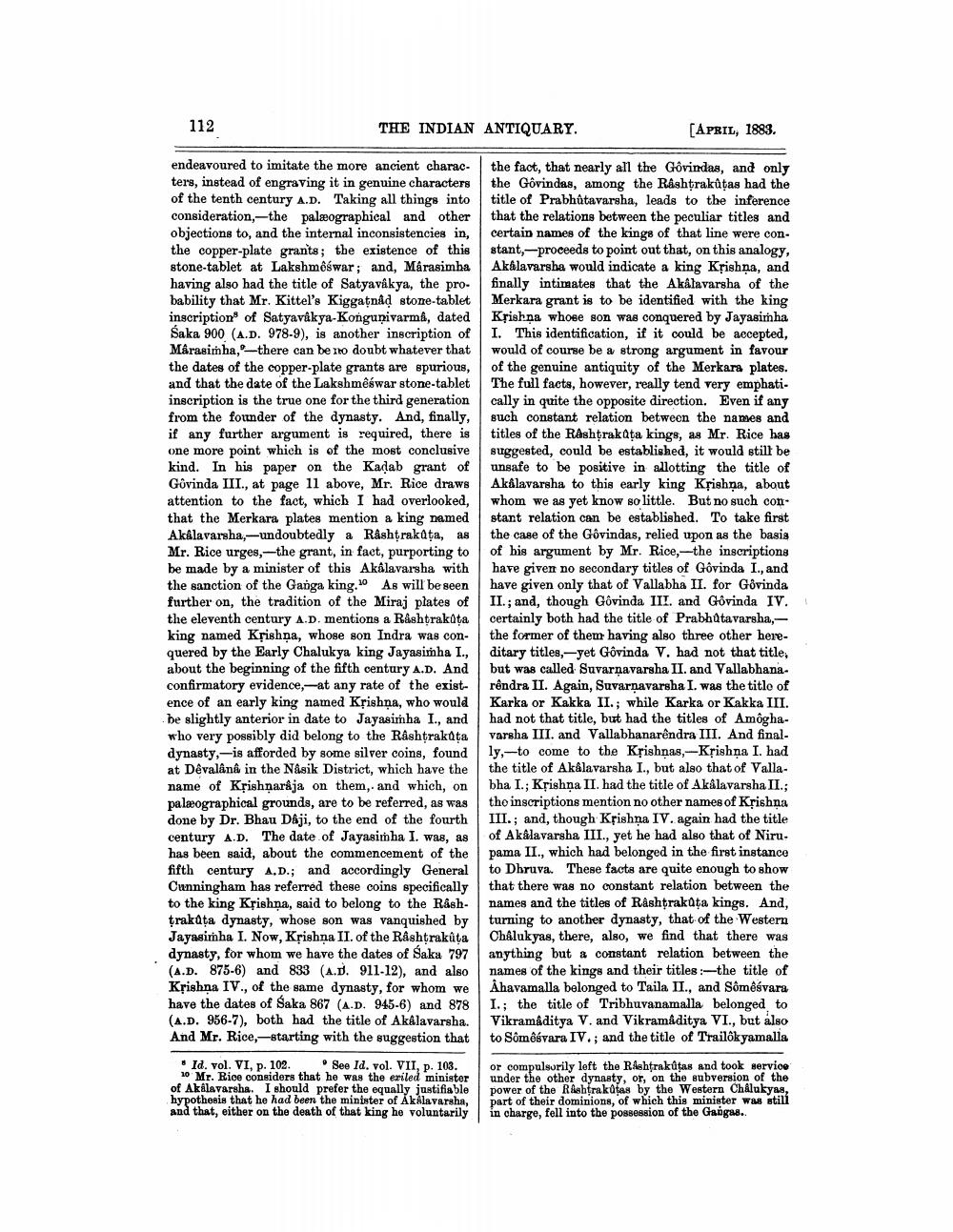________________
112
THE INDIAN ANTIQUARY.
[APRIL, 1883.
endeavoured to imitate the more ancient charac- ters, instead of engraving it in genuine characters of the tenth century A.D. Taking all things into consideration, the palæographical and other objections to, and the internal inconsistencies in, the copper-plate grants; the existence of this stone-tablet at Lakshmôśwar; and, Márasimha having also had the title of Satyavákya, the pro. bability that Mr. Kittel's Kiggatnad stone-tablet inscription of Satyavákya-Kongunivarma, dated Saka 900 (A.D. 978-9), is another inscription of Mârasimha,—there can be no doubt whatever that the dates of the copper-plate grants are spurious, and that the date of the Lakshmêswar stone-tablet inscription is the true one for the third generation from the founder of the dynasty. And, finally, if any further argument is required, there is one more point which is of the most conclusive kind. In his paper on the Kadab grant of Govinda III., at page 11 above, Mr. Rice draws attention to the fact, which I had overlooked, that the Merkara plates mention a king named Akálavarsha, -undoubtedly a Råshtrakata, as Mr. Rice urges,-the grant, in fact, purporting to be made by a minister of this Akálavarsha with the sanction of the Ganga king. As will be seen further on, the tradition of the Miraj plates of the eleventh century A.D. mentions a R&shtrakata king named Krishna, whose son Indra was conquered by the Early Chalukya king Jayasimha I., about the beginning of the fifth century A.D. And confirmatory evidence,-at any rate of the exist- ence of an early king named Krishna, who would be slightly anterior in date to Jayasinha I., and who very possibly did belong to the Rashtrakata dynasty,- is afforded by some silver coins, found at Dêvalânâ in the Násik District, which have the name of Krishnaraja on them, and which, on palæographical grounds, are to be referred, as was done by Dr. Bhau Daji, to the end of the fourth century A.D. The date of Jayasimha I. was, as has been said, about the commencement of the fifth century A.D.; and accordingly General Cunningham has referred these coins specifically to the king Krishna, said to belong to the Rashtrakața dynasty, whose son was vanquished by Jayasimha I. Now, Krishna II. of the Rashtrakůta dynasty, for whom we have the dates of Saka 797 (A.D. 875-6) and 833 (A.D. 911-12), and also Krishna IV., of the same dynasty, for whom we have the dates of Saka 867 (A.D. 945-6) and 878 (A.D. 956-7), both had the title of Akalavarsha. And Mr. Rice, starting with the suggestion that
the fact, that nearly all the Govindas, and only the Govindas, among the Rashtrakūtas had the title of Prabhûtavarsha, leads to the inference that the relations between the peculiar titles and certain names of the kings of that line were constant,-proceeds to point out that, on this analogy, Akalavarsha would indicate a king Krishna, and finally intimates that the Akalavarsha of the Merkara grant is to be identified with the king Krishna whose son was conquered by Jayasimha I. This identification, if it could be accepted, would of course be a strong argument in favour of the genuine antiquity of the Merkara plates. The full facts, however, really tend very emphatically in quite the opposite direction. Even if any Buch constant relation between the names and titles of the Rashtrakata kings, as Mr. Rice has suggested, could be established, it would still be unsafe to be positive in allotting the title of Akalavarsha to this early king Kộishna, about whom we as yet know so little. But no such constant relation can be established. To take first the case of the Govindas, relied upon as the basis of his argument by Mr. Rice,-the inscriptions have given no secondary titles of Govinda I., and have given only that of Vallabha II. for Govinda II.; and, though Govinda III. and Govinda IV. certainly both had the title of Prabhutavarsha, - the former of them having also three other hereditary titles, yet Govinda V. had not that title, but was called Suvarnavarsha II. and Vallabhanarêndra II. Again, Suvarņavarsha I. was the titlo of Karka or Kakka II. ; while Karka or Kakka III. had not that title, but had the titles of Amôghavarsha III. and Vallabhanarendra III. And finally,--to come to the Krishnas ---Kộishna I. had the title of Akalavarsha I., but also that of Vallabha I.; Krishna II. had the title of Akalavarsha II.; tho inscriptions mention no other names of Krishna III.; and, though Krishna IV. again had the title of Akalavarsha III., yet he had also that of Niru. pama II., which had belonged in the first instance to Dhruva. These facts are quite enough to show that there was no constant relation between the names and the titles of Rashtrakåta kings. And, turning to another dynasty, that of the Western Chalukyas, there, also, we find that there was anything but a constant relation between the names of the kings and their titles :-the title of Åhavamalla belonged to Taila II., and Sômêsvara I.; the title of Tribhuvanamalla belonged to Vikramaditya V. and Vikramaditya VI., but also to Sômêsvara IV.; and the title of Trailokyamalla
* Id. vol. VI, p. 102. See Id. vol. VII, p. 103.
10 Mr. Rice considers that he was the exiled minister of Akalavarsha. I should prefer the equally justifiable hypothesis that he had been the minister of AkAlavarsha, and that, either on the death of that king he voluntarily
or compulsurily left the RAshtrakůtas and took service under the other dynasty, or, on the subversion of the power of the Rashtrakūtas by the Western Chålukyas, part of their dominions, of which this minister was still in charge, fell into the possession of the Gangas..




